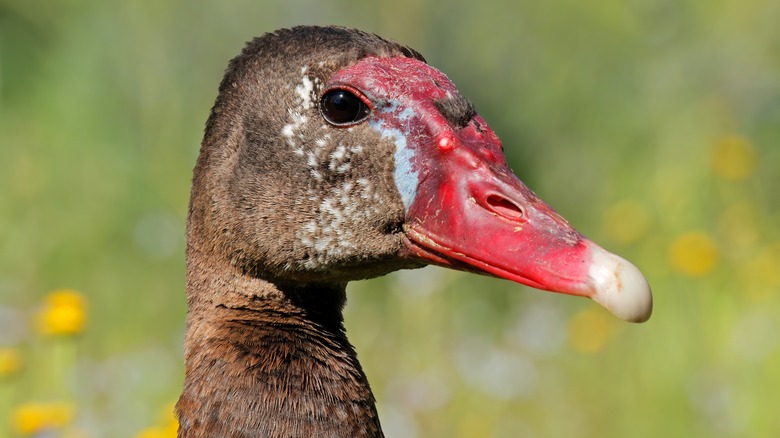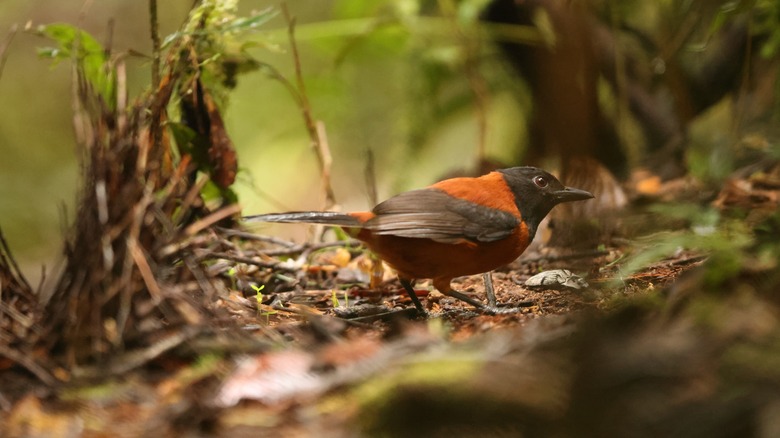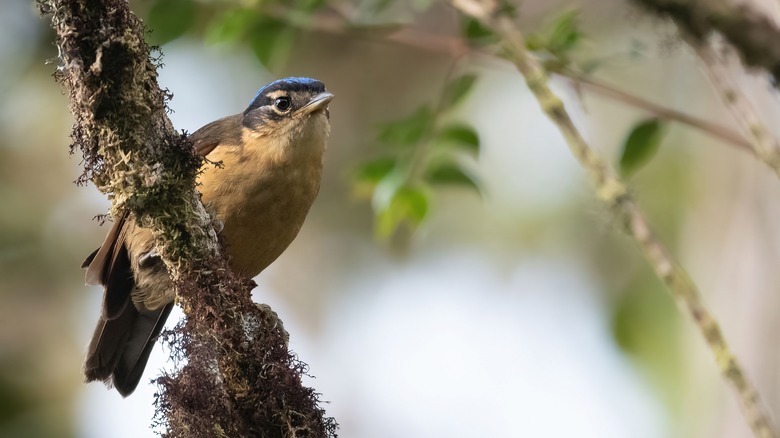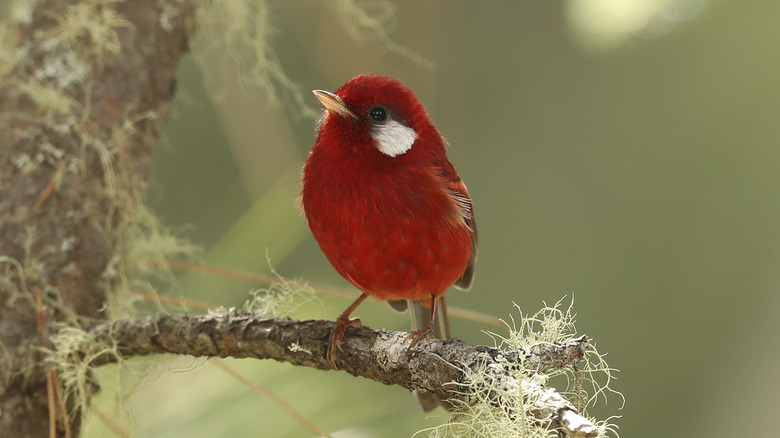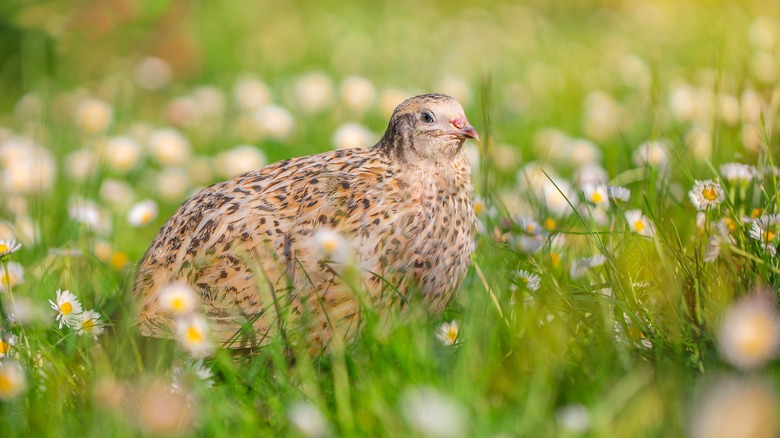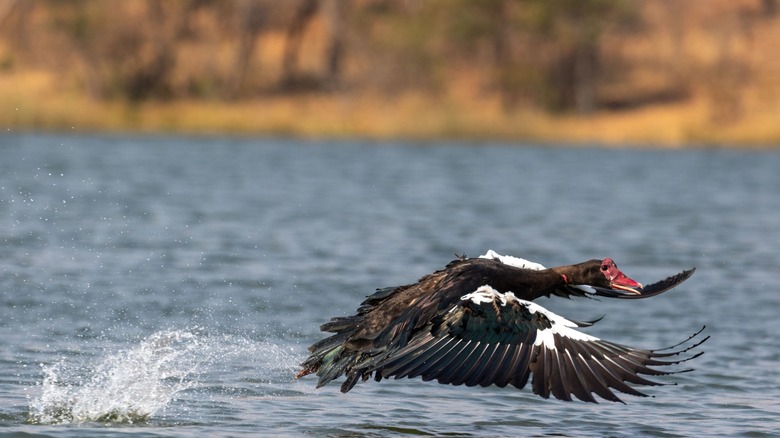5 Birds That Are Actually Poisonous
When you think of poisonous animals, you don't necessarily think of birds first. Snakes, perhaps. Frogs? Maybe. Heck, even poisonous spiders probably spring to mind before birds — which, it should be said, can be dangerous in their own way. Cassowaries, for instance, have been known to kill humans using their sharp nails and are widely considered the world's most dangerous birds. Meanwhile the strength of an ostrich kick can kill lions. But neither of these potentially lethal birds are poisonous.
As unlikely as it may seem, however, toxic birds do exist, though they were almost entirely unknown until the 1990s. Today, we have a much better understanding of poisonous birds, but they still remain somewhat mysterious. It's worth noting that none of these species produce toxins themselves. Rather, the birds engage in a process that produces something called heteroaglandular poison — i.e. poison produced as a result of consuming a certain toxin which is then re-used by the bird for its own defenses. This happens when the birds eat poisonous plants or animals, and since the birds in question have a specific protein that soaks up the toxin, the bird is able to resist the poisonous effects and repurpose the poison. With that out of the way, here are five of the most toxic birds in existence.
Hooded Pitohui
Arguably the king of poisonous birds, the Hooded Pitohui is actually part of a family of pitohui bird, all six of which are found in New Guinea. Of these, the Hooded variety are particularly toxic due to the fact their skin and feathers are covered in a neurotoxin known as batrachotoxin. If that sounds terrifying, it isn't quite as bad as you might imagine. Touching one of these birds isn't going to trigger hallucinations or anything like that, but it will very likely result in numbness, tingling, or maybe even skin burns.
Batrachotoxin is the same poison found in dart frogs, and while it is to be avoided as much as possible, it isn't life-threatening to humans. Interestingly enough, the source of these birds' toxicity is thought to be their diet, with the Hooded Pitohui feasting on beetles from the genus Choresine, which contain the toxin.
The Hooded Pitohui is deceptive in that while it is toxic, it's also a songbird with an alluring red-brown and black plumage. The birds also measure just 8.7 to 9.1 inches in length and typically weigh between 2.3 to 2.7 ounces. As such, this pitohui doesn't look all that intimidating, and you'd never know that the species was covered from beak to tail in poison.
Blue-capped Ifrita Bird
It might not be the deadliest animal in the rainforests of New Guinea, but the Blue-capped Ifrita, like the Hooded Pitohui, is yet another bird that is covered in poison. This bird is perhaps even more visually impressive than the Hooded Pitohui, measuring just 6.5 inches long on average with yellowish brown plumage and a blue and black crown. But the Ifrita is also covered in batrachotoxins, which sits on their skin and feathers and which can cause serious skin irritation for humans. Like the Hooded Pitohui, the source of this toxin is thought to be Choresine beetles, which the Blue-capped Ifrita eat as part of their diet.
A 2000 study published in Bioscience noted how natives of New Guinea have dubbed the Ifrita "Slek-Yakt," or "bitter bird," and claim that consuming the bird results in "a burning sensation in the mouth." Coughing and "allergy-like reactions" were also reported as a result of "breathing deeply from the bird's plumage." Much like with the Pitohui, then, the Ifrita is not life-threatening to humans, but it's probably best to stay away from the bird completely covered in a neurotoxin if possible.
Red Warbler
The Red Warbler has a bright red plumage and is common in the Mexican highlands, where it lives in conifer and pine-oak forests. The bird's cheek patch differs depending on the location, with warblers from central and southern Mexico having a white patch, while those in northwest Mexico feature a silvery gray version. But much like its counterparts from New Guinea, the Red Warbler carries toxins in its feathers, making it another deceptively beautiful bird.
The Red Warbler also shares a similar diet to the Hooded Pitohui and Blue-capped Ifrita in that it is entirely insectivorous, meaning its poison more than likely comes from eating a certain toxic bug. The specific toxin on the Warbler's feathers remains unidentified but appears to include two neurotoxic alkaloids, which means handling the bird should be avoided. The ancient Aztecs appeared to be well aware of the Warbler's toxicity, too, recording that a small red bird was inedible.
European quail or common quail
Of all the birds on this list, the European quail (otherwise known as the common quail) is the one that has caused the most harm to humans. A quiet menace, this deceptively charming gamebird, with its small size and light brown plumage, has poisoned enough humans that there's a name for quail poisoning. As noted in a study published in the Journal of Cultural Geography all the way back in 1987, coturnism is "human poisoning from European migratory quail," and while the name itself is a relatively recent development, the phenomenon itself has been known about since ancient times.
Essentially, the European quail has been running around poisoning humans for centuries. But how? Well, this quail isn't actually toxic year-round. At certain times of the year, the bird carries coniine, a toxic alkaloid which, like the other examples on this list, does not come from the quail itself but is imbibed as part of its diet. The quail eat hemlock seeds during their migration, which means that they become toxic during either the spring or the fall migration periods, depending on their specific location. Unlike other species, the European quail appear to have evolved to resist the neurotoxic poison in hemlock, and simply carry it with them after consuming the seeds.
Eating one of the toxic quail during a time when it has taken on coniine can lead to severe health issues, with the aforementioned study noting that Coturnism can lead to weakness which progresses to "severe muscle pain and lower limb paralysis," as well as vomiting, discolored urine, possible severe gastroenteritis-diarrhea, fever, voice loss, and even death caused by cardiac or kidney failure.
Spur-winged Goose
Unlike other birds on this list, the Spur-winged Goose does not hide its toxicity behind an appealing appearance. These imposing birds are the largest waterfowl in Africa, and the largest species of goose in the world, weighing up to 20 pounds. What's more, they are highly aggressive and territorial. Their size and aggression, coupled with the fact they have a sharp spur on their wings, already makes them an intimidating animal. But when you add poison into the mix, the Spur-winged Goose becomes a genuinely frightening bird.
Residing in Africa, not all Spur-winged Geese are poisonous. The birds in the Gambia region, however, eat the blister beetle as part of their diet, which imbues them with a poison called cantharidin. This then inhabits the tissue of the geese, giving them a layer of toxicity. While the birds themselves have developed an immunity to the toxin, 10mg of cantharidin can prove fatal for humans, so this is one waterfowl that it's best not to eat, or go anywhere near if possible.
